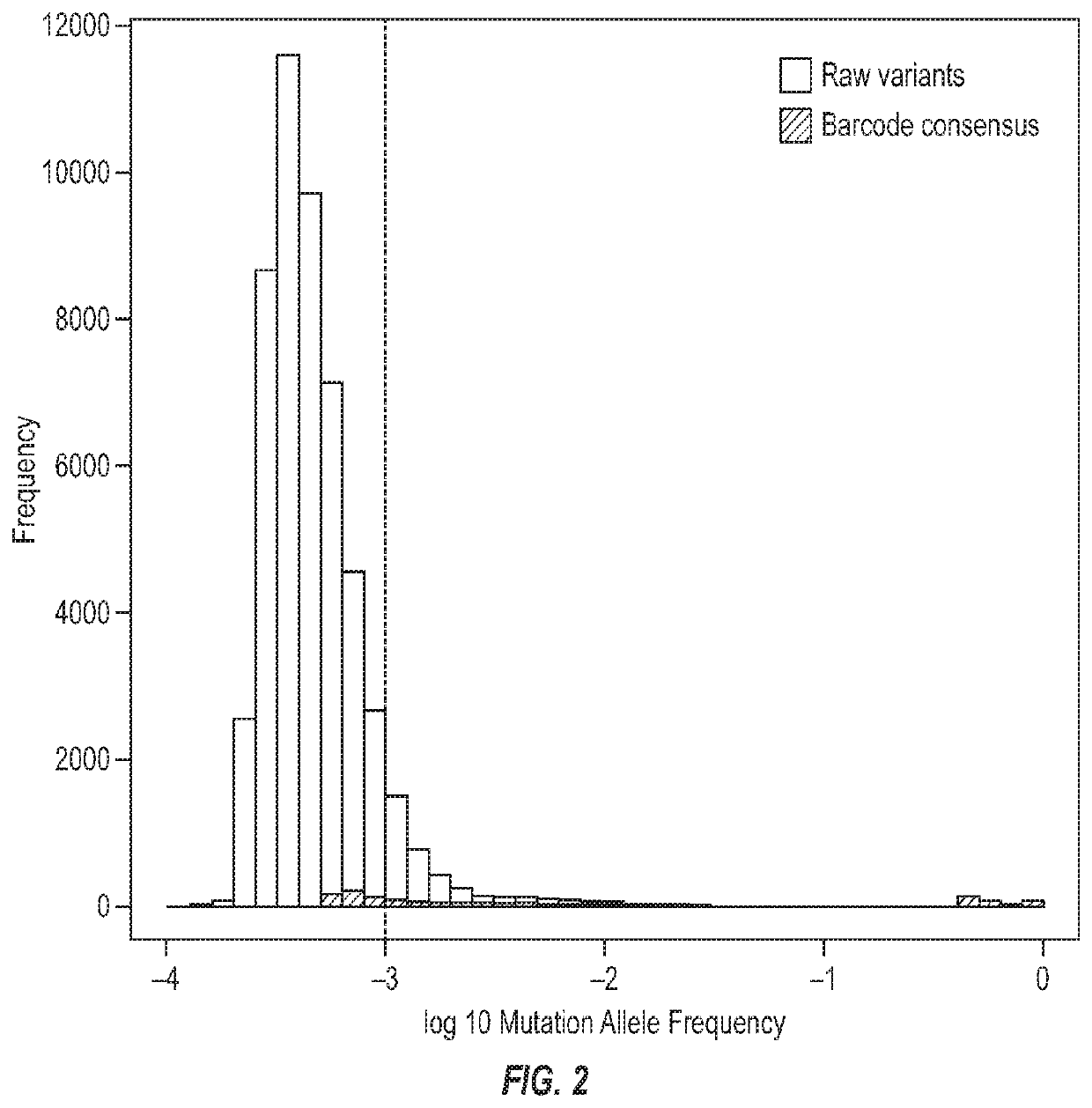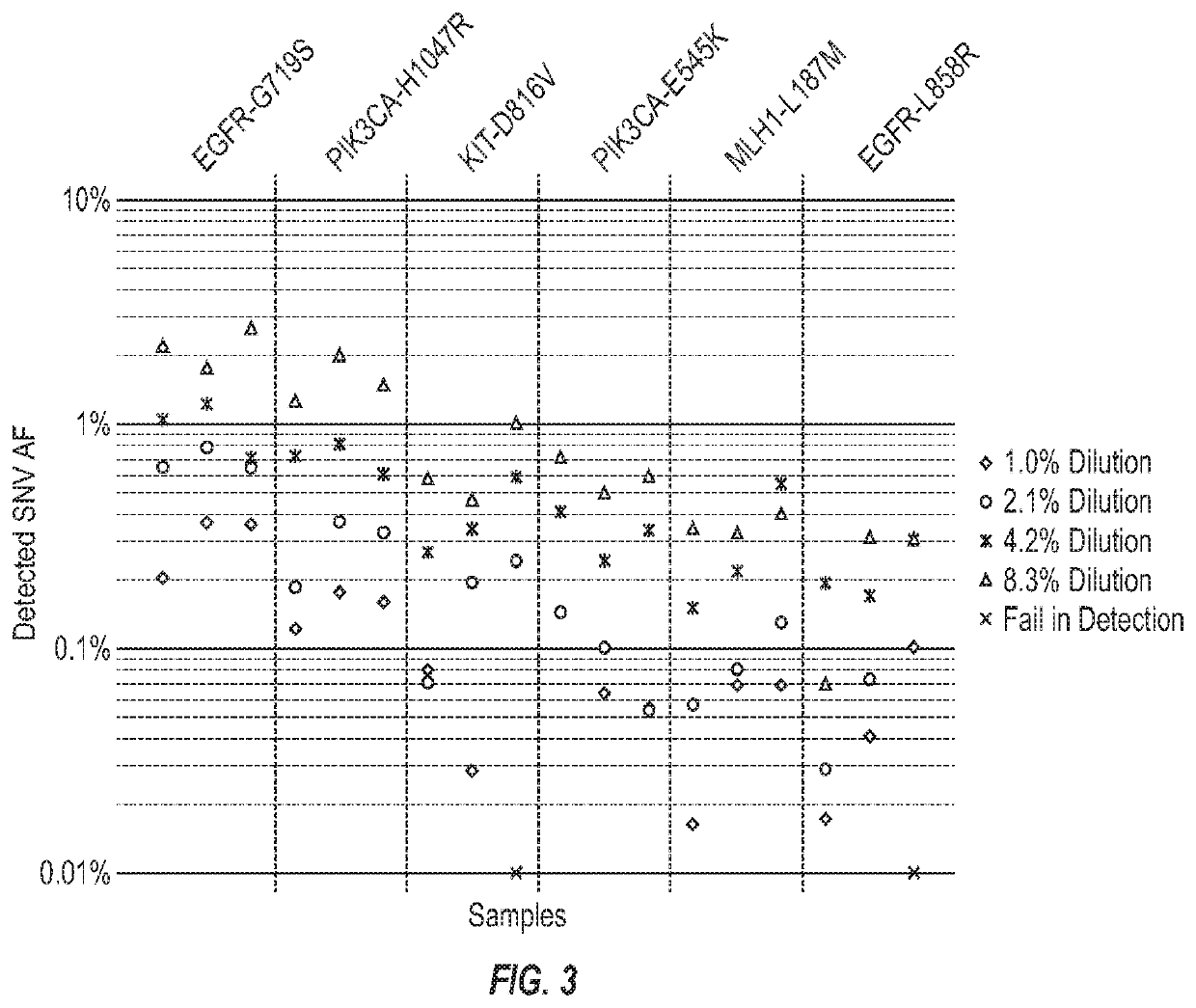Systems and methods for combined detection of genetic alterations
a combined detection and gene technology, applied in the field of precision medicine, can solve the problems of loss of both, cost and time-consuming separation process, etc., and achieve the effect of reducing sequencing and pcr errors and increasing barcode diversity
- Summary
- Abstract
- Description
- Claims
- Application Information
AI Technical Summary
Benefits of technology
Problems solved by technology
Method used
Image
Examples
example 1
llele Frequency Before and after Barcode Consensus Noise Suppression
[0064]To compare the performance of Gene RADAR and traditional next-generation sequencing using Picard deduplication, which lacks a consensus calling feature, 1.25 ng Horizon reference HD701 was spiked in to normal cfDNA to get 30 ng mixed DNA as input for PrediSeq-Pan Cancer assay. Results from Gene RADAR's analysis pipeline and traditional method were compared and are shown in FIG. 2. Using the traditional method, there were 50,820 identified variants (3,838 variants with variant frequency >0.1%). After applying Gene RADAR's consensus error correction, only 1,104 variants were identified (642 variants with variant frequency >0.1%). This indicates that Gene RADAR's consensus error correction reduces background noise by 97.8% (or 85.1% for variants with AF>0.1%). It was demonstrated that Gene RADAR's error suppression feature enables ultra-high quality sequencing of each input molecule of cfDNA.
example 2
ection Analysis Sensitivity and Accuracy
[0065]To evaluate analytic sensitivity of the PrediSeq-Pan Cancer assay, spike-in of Horizon reference DNA (HD701) was used, and 6 different SNVs were chosen for analysis. Four serial dilution ratios at 8.3%, 4.2%, 2.1%, 1.0% were used in triplicate samples to make a total 72 SNV targets. The SNV allele frequency at which >90% (18 of 20) of SNVs are detected is defined as the limit of detection, and it was calculated at 0.1% based on the data (FIG. 3). To assess the analytical accuracy of the assay's SNV AF detection, we analyzed this same set of data, choosing the SNVs with detected AF>0.1% and calculated the correlation between detected and expected AF, at 0.938.
example 3
Combined Detection has Better Coverage than cfDNA Detection Alone and Additional Sensitivity and Accuracy Contributed by cfRNA Utilization
[0066]Gene RADAR technology utilizes cfDNA and cfRNA from the same sample simultaneously, which adds additional sequencing coverage compared to cfDNA sequencing alone. For the proof of concept study, prostate cancer DNA and RNA was extracted and sequenced from Vcap cell line supernatant. The coverage differences of selected cancer related target genes in DNA only vs. DNA+RNA are presented in FIG. 3. The black dots represent the genes which have matched DNA and RNA level variants. Roughly 17.5% of genes in the selected panel benefits from at least 10% coverage, and thus higher sensitivity contributed by the cfRNA input. In additional, 46.9% of the mutations detected from cfDNA were also detected in the same location from cfRNA (supported by at least 3 reads with target mutation). Therefore, by combining DNA and RNA, additional read coverage and hig...
PUM
 Login to View More
Login to View More Abstract
Description
Claims
Application Information
 Login to View More
Login to View More - R&D
- Intellectual Property
- Life Sciences
- Materials
- Tech Scout
- Unparalleled Data Quality
- Higher Quality Content
- 60% Fewer Hallucinations
Browse by: Latest US Patents, China's latest patents, Technical Efficacy Thesaurus, Application Domain, Technology Topic, Popular Technical Reports.
© 2025 PatSnap. All rights reserved.Legal|Privacy policy|Modern Slavery Act Transparency Statement|Sitemap|About US| Contact US: help@patsnap.com



